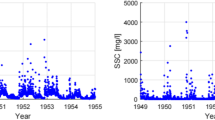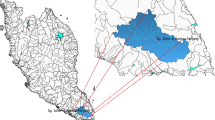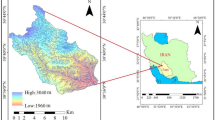Abstract
Precise assessment of suspended sediment load (SSL) is vital for many applications in hydrological modeling and hydraulic engineering. In this study, a smoothed long short-term memory (SM-LSTM) model was used to predict day-to-day SSL at two stations over two rivers namely Thebes station on the Mississippi River and Omaha station on the Missouri River. The model first removes the interference factors in the SSL time series by Fourier Transformation (FT) de-noising and then feeds into a long short-term memory (LSTM) network to forecast the SSL. Before de-noising, missing data in the time series is computed using the Monte Carlo multiple imputation technique. LSTM networks are a type of recurrent neural network (RNN) that incorporates memory cells, which makes them well-suited for learning temporal associations over the previous time steps. The model was built using daily observed time series of SSL in the Mississippi and Missouri rivers in the United States. The developed model was then assessed and compared to LSTM and RNN. These models were trained using 4 different time lags of the SSL time series as inputs. The SM-LSTM model with 12 lagged inputs outperformed the other models with the lowest root mean square errors (RMSE) = 32254 ton and mean absolute errors (MAE) = 19517 ton, and the highest Nash–Sutcliffe efficiency (NSE) = 0.99 for the Thebes Station while the model with 3 lagged inputs acted as the best with the lowest RMSE = 2244 ton and MAE = 1370 ton, and the highest NSE = 0.989 for the Omaha Station. The comparison of prediction accuracies showed that the SM-LSTM model can more satisfactorily predict daily SSL time series compared to LSTM and RNN.










Similar content being viewed by others
Data Availability Statement
Datasets derived from public resources and available in the USGS Water Data for the Nation (https://waterdata.usgs.gov/nwis).
References
Achite M, Yaseen ZM, Heddam S, Malik A, Kisi O (2021) Advanced machine learning models development for suspended sediment prediction: comparative analysis study. Geocarto Int 1–25
Adikari KE, Shrestha S, Ratnayake DT, Budhathoki A, Mohanasundaram S, Dailey MN (2021) Evaluation of artificial intelligence models for flood and drought forecasting in arid and tropical regions. Environ Model Softw 144:105136
Adnan RM, Parmar KS, Heddam S, Shahid S, Kisi O (2021) Suspended sediment modeling using a heuristic regression method hybridized with kmeans clustering. Sustainability 13(9):4648
Adnan RM, Yaseen ZM, Heddam S, Shahid S, Sadeghi-Niaraki A, Kisi O (2022) Predictability performance enhancement for suspended sediment in rivers: Inspection of newly developed hybrid adaptive neuro-fuzzy system model. Int J Sedim Res 37(3):383–398
AlDahoul N, Essam Y, Kumar P, Ahmed AN, Sherif M, Sefelnasr A, Elshafie A (2021) Suspended sediment load prediction using long short-term memory neural network. Sci Rep 11(1):7826. https://doi.org/10.1038/s41598-021-87415-4
Bai P, Liu X, Xie J (2021) Simulating runoff under changing climatic conditions: a comparison of the long short-term memory network with two conceptual hydrologic models. J Hydrol 592:125779
Banadkooki FB, Ehteram M, Ahmed AN, Teo FY, Ebrahimi M, Fai CM, Huang YF, El-Shafie A (2020) Suspended sediment load prediction using artificial neural network and ant lion optimization algorithm. Environ Sci Pollut Res 27(30):38094–38116
Barzegar R, Aalami MT, Adamowski J (2021) Coupling a hybrid CNN-LSTM deep learning model with a Boundary Corrected Maximal Overlap Discrete Wavelet Transform for multiscale Lake water level forecasting. J Hydrol 598:126196
Bhattacharya B, Solomatine DP (2006) Machine learning in sedimentation modelling. Neural Netw 19(2):208–214
Bisoyi N, Gupta H, Padhy NP, Chakrapani GJ (2019) Prediction of daily sediment discharge using a back propagation neural network training algorithm: A case study of the Narmada River, India. Int J Sediment Res 34(2):125–135
Chang Q, Zhang C, Zhang S, Li B (2019) Streamflow and sediment declines in a loess hill and gully landform basin due to climate variability and anthropogenic activities. Water 11(11):2352
Cho M, Kim C, Jung K, Jung H (2022) Water Level Prediction Model Applying a Long Short-Term Memory (LSTM)–Gated Recurrent Unit (GRU) Method for Flood Prediction. Water 14(14):2221
Choubin B, Darabi H, Rahmati O, Sajedi-Hosseini F, Kløve B (2018) River suspended sediment modelling using the CART model: A comparative study of machine learning techniques. Sci Total Environ 615:272–281
Darabi H, Mohamadi S, Karimidastenaei Z, Kisi O, Ehteram M, ELShafie A, Torabi Haghighi A (2021) Prediction of daily suspended sediment load (SSL) using new optimization algorithms and soft computing models. Soft Comput 25(11):7609–7626
Deng H, Chen W, Huang G (2022) Deep insight into daily runoff forecasting based on a CNN-LSTM model. Nat Hazards 1–22
Du B, Zhou Q, Guo J, Guo S, Wang L (2021) Deep learning with long short-term memory neural networks combining wavelet transform and principal component analysis for daily urban water demand forecasting. Expert Syst Appl 171:114571
Ehteram M, Ahmed AN, Latif SD, Huang YF, Alizamir M, Kisi O, Mert C, El-Shafie A (2021) Design of a hybrid ANN multi-objective whale algorithm for suspended sediment load prediction. Environ Sci Pollut Res 28(2):1596–1611
Faruq A, Abdullah SS, Marto A, Bakar MAA, Mubin A (2020) River water level forecasting for flood warning system using deep learning long short-term memory network. IOP Conf Ser Mater Sci Eng 821(1):012026 (IOP Publishing)
Fathabadi A, Seyedian SM, Malekian A (2022) Comparison of Bayesian, k-Nearest Neighbor and Gaussian process regression methods for quantifying uncertainty of suspended sediment concentration prediction. Sci Total Environ 818:151760
Feng D, Fang K, Shen C (2020) Enhancing streamflow forecast and extracting insights using long-short term memory networks with data integration at continental scales. Water Resour Res 56(9):e2019WR026793
Galat DL, Berry CS, Peters EJ, White RG (2005) Missouri River Basin. In: Benke AC, Cushing CE (eds) Rivers of North America. Elsevier, Burlington, MA, pp 427–480
Gauch M, Kratzert F, Klotz D, Nearing G, Lin J, Hochreiter S (2021) Rainfall–runoff prediction at multiple timescales with a single Long Short-Term Memory network. Hydrol Earth Syst Sci 25(4):2045–2062
Ghanbari-Adivi E, Ehteram M, Farrokhi A, Sheikh Khozani Z (2022) Combining radial basis function neural network models and inclusive multiple models for predicting suspended sediment loads. Water Resour Manag 36(11):4313–4342
Gholami V, Booij M, Tehrani EN, Hadian M (2018) Spatial soil erosion estimation using an artificial neural network (ANN) and field plot data. CATENA 163:210–218
Gupta D, Hazarika BB, Berlin M, Sharma UM, Mishra K (2021) Artificial intelligence for suspended sediment load prediction: a review. Environ Earth Sci 80(9):1–39
Han H, Choi C, Jung J, Kim HS (2021) Deep learning with long short term memory based Sequence-to-Sequence model for Rainfall-Runoff simulation. Water 13(4):437
Hochreiter S, Schmidhuber J (1997) Long short-term memory. Neural Comput 9(8):1735–1780
Hu C, Wu Q, Li H, Jian S, Li N, Lou Z (2018) Deep learning with a long short-term memory networks approach for rainfall-runoff simulation. Water 10(11):1543
Hussain D, Hussain T, Khan AA, Naqvi SAA, Jamil A (2020) A deep learning approach for hydrological time-series prediction: A case study of Gilgit river basin. Earth Sci Inf 13(3):915–927
Kabir S, Patidar S, Xia X, Liang Q, Neal J, Pender G (2020) A deep convolutional neural network model for rapid prediction of fluvial flood inundation. J Hydrol 590:125481
Kao I-F, Zhou Y, Chang L-C, Chang F-J (2020) Exploring a Long Short-Term Memory based Encoder-Decoder framework for multi-step-ahead flood forecasting. J Hydrol 583:124631
Kaveh K, Kaveh H, Bui MD, Rutschmann P (2021) Long short-term memory for predicting daily suspended sediment concentration. Engineering with Computers 37(3):2013–2027
Khan MYA, Tian F, Hasan F, Chakrapani GJ (2019) Artificial neural network simulation for prediction of suspended sediment concentration in the River Ramganga, Ganges Basin. India International Journal of Sediment Research 34(2):95–107
Khosravi K, Golkarian A, Tiefenbacher JP (2022) Using optimized deep learning to predict daily streamflow: a comparison to common machine learning algorithms. Water Resour Manage 36(2):699–716
Kim DY, Song CM (2020) Developing a discharge estimation model for ungauged watershed using CNN and hydrological image. Water 12(12):3534
Kişi Ö (2010) River suspended sediment concentration modeling using a neural differential evolution approach. J Hydrol 389(1–2):227–235
Kisi O, Dailr AH, Cimen M, Shiri J (2012) Suspended sediment modeling using genetic programming and soft computing techniques. J Hydrol 450:48–58
Kisi O, Zounemat-Kermani M (2016) Suspended sediment modeling using neuro-fuzzy embedded fuzzy c-means clustering technique. Water Resour Manage 30(11):3979–3994
Kratzert F, Klotz D, Brenner C, Schulz K, Herrnegger M (2018) Rainfall–runoff modelling using long short-term memory (LSTM) networks. Hydrol Earth Syst Sci 22(11):6005–6022
Latif SD, Ahmed AN (2023) Streamflow prediction utilizing deep learning and machine learning algorithms for sustainable water supply management. Water Resour Manag 1–15
Le X-H, Ho HV, Lee G, Jung S (2019) Application of long short-term memory (LSTM) neural network for flood forecasting. Water 11(7):1387
Lee S, An H, Hur Y, Kim Y, Byun J (2020) Flood prediction in the Namgang Dam basin using a long short-term memory (LSTM) algorithm. Korean Journal of Agricultural Science 47(3):471–483
Lees T, Buechel M, Anderson B, Slater L, Reece S, Coxon G, Dadson SJ (2021) Benchmarking data-driven rainfall–runoff models in Great Britain: a comparison of long short-term memory (LSTM)-based models with four lumped conceptual models. Hydrol Earth Syst Sci 25(10):5517–5534
Li S, Yang J (2022) Modelling of suspended sediment load by Bayesian optimized machine learning methods with seasonal adjustment. Eng Appl Comput Fluid Mech 16(1):1883–1901
Li W, Kiaghadi A, Dawson C (2021) High temporal resolution rainfall–runoff modeling using long-short-term-memory (LSTM) networks. Neural Comput Appl 33(4):1261–1278
Li Y, Wang W, Wang G, Tan Q (2022) Actual evapotranspiration estimation over the Tuojiang River Basin based on a hybrid CNN-RF model. J Hydrol 610:127788
Liu B, Tang Q, Zhao G, Gao L, Shen C, Pan B (2022) Physics-guided long short-term memory network for streamflow and flood simulations in the Lancang-Mekong River Basin. Water 14(9):1429
Livieris IE, Stavroyiannis S, Iliadis L, Pintelas P (2021) Smoothing and stationarity enforcement framework for deep learning time-series forecasting. Neural Comput Appl 33(20):14021–14035
Malik A, Kumar A, Piri J (2017) Daily suspended sediment concentration simulation using hydrological data of Pranhita River Basin, India. Comput Electron Agric 138:20–28
Mao G, Wang M, Liu J, Wang Z, Wang K, Meng Y, Zhong R, Wang H, Li Y (2021) Comprehensive comparison of artificial neural networks and long short-term memory networks for rainfall-runoff simulation. Phys Chem Earth Parts a/b/c 123:103026
Melesse A, Ahmad S, McClain M, Wang X, Lim Y (2011) Suspended sediment load prediction of river systems: An artificial neural network approach. Agric Water Manag 98(5):855–866
Moeeni H, Bonakdari H (2018) Impact of normalization and input on ARMAX-ANN model performance in suspended sediment load prediction. Water Resour Manag 32(3):845–863
Mohanta NR, Biswal P, Kumari SS, Samantaray S, Sahoo A (2021) Estimation of sediment load using adaptive neuro-fuzzy inference system at Indus River Basin, India. In Intelligent data engineering and analytics: frontiers in intelligent computing: theory and applications (FICTA 2020), vol 2. Springer, Singapore, pp 427–434
Muhamad NS, Din AM (2016) Neural network forecasting model using smoothed data. AIP Conf Proc 1782(1):040012 (AIP Publishing)
Nanda T, Sahoo B, Chatterjee C (2019) Enhancing real-time streamflow forecasts with wavelet-neural network based error-updating schemes and ECMWF meteorological predictions in Variable Infiltration Capacity model. J Hydrol 575:890–910
Ni L, Wang D, Singh VP, Wu J, Wang Y, Tao Y, Zhang J (2020) Streamflow and rainfall forecasting by two long short-term memory-based models. J Hydrol 583:124296
Ni L, Wang D, Wu J (2019) Streamflow forecasting using long short-term memory network. Risk analysis based on data and crisis response beyond knowledge. Taylor & Francis Group, London, pp 264–269
Nourani V, Andalib G (2015) Daily and monthly suspended sediment load predictions using wavelet based artificial intelligence approaches. J Mt Sci 12(1):85–100
Nourani V, Molajou A, Tajbakhsh AD, Najafi H (2019) A wavelet based data mining technique for suspended sediment load modeling. Water Resour Manag 33(5):1769–1784
Pérez-Alarcón A, Garcia-Cortes D, Fernández-Alvarez JC, Martínez-González Y (2022) Improving monthly rainfall forecast in a watershed by combining neural networks and autoregressive models. Environ Process 9(3):53
Raghuwanshi NS, Singh R, Reddy L (2006) Runoff and sediment yield modeling using artificial neural networks: Upper Siwane River, India. J Hydrol Engin 11(1):71–79
Ravindran SM, Bhaskaran SKM, Ambat SKN (2021) A deep neural network architecture to model reference evapotranspiration using a single input meteorological parameter. Environ Process 8(4):1567–1599
Roy DK (2021) Long short-term memory networks to predict one-step ahead reference evapotranspiration in a subtropical climatic zone. Environ Process 8:911–941
Sahoo BB, Jha R, Singh A, Kumar D (2019) Long short-term memory (LSTM) recurrent neural network for low-flow hydrological time series forecasting. Acta Geophys 67(5):1471–1481
Samantaray S, Ghose DK (2018) Evaluation of suspended sediment concentration using descent neural networks. Procedia Computer Science 132:1824–1831
Samet K, Hoseini K, Karami H, Mohammadi M (2019) Comparison between soft computing methods for prediction of sediment load in rivers: Maku dam case study. Iran J Sci Technol Trans Civil Eng 43(1):93–103
Sharafati A, Haji Seyed Asadollah SB, Motta D, Yaseen ZM (2020) Application of newly developed ensemble machine learning models for daily suspended sediment load prediction and related uncertainty analysis. Hydrol Sci J 65(12):2022–2042
Sharghi E, Nourani V, Najafi H, Gokcekus H (2019a) Conjunction of a newly proposed emotional ANN (EANN) and wavelet transform for suspended sediment load modeling. Water Supply 19(6):1726–1734
Sharghi E, Nourani V, Najafi H, Soleimani S (2019b) Wavelet-exponential smoothing: a new hybrid method for suspended sediment load modeling. Environ Process 6(1):191–218
Shiri N, Shiri J, Nourani V, Karimi S (2022) Coupling wavelet transform with multivariate adaptive regression spline for simulating suspended sediment load: independent testing approach. ISH J Hydraul Eng 28(sup1):356–365
Song T, Ding W, Wu J, Liu H, Zhou H, Chu J (2019) Flash flood forecasting based on long short-term memory networks. Water 12(1):109
Tao H, Keshtegar B, Yaseen ZM (2019) The feasibility of integrative radial basis M5Tree predictive model for river suspended sediment load simulation. Water Resour Manag 33(13):4471–4490
Tian H, Wang P, Tansey K, Zhang J, Zhang S, Li H (2021) An LSTM neural network for improving wheat yield estimates by integrating remote sensing data and meteorological data in the Guanzhong Plain, PR China. Agric For Meteorol 310:108629
Tiwari MK, Chatterjee C (2011) A new wavelet–bootstrap–ANN hybrid model for daily discharge forecasting. J Hydroinf 13(3):500–519
Tu T, Ishida K, Ercan A, Kiyama M, Amagasaki M, Zhao T (2021) Hybrid precipitation downscaling over coastal watersheds in Japan using WRF and CNN. J Hydrol Reg Stud 37:100921
Wang Y, Fang Z, Hong H, Peng L (2020) Flood susceptibility mapping using convolutional neural network frameworks. J Hydrol 582:124482
Wegayehu EB, Muluneh FB (2022) Short-term daily univariate streamflow forecasting using deep learning models. Adv Meteorol 2022:1860460
Wibawa AP, Utama ABP, Elmunsyah H, Pujianto U, Dwiyanto FA, Hernandez L (2022) Time-series analysis with smoothed Convolutional Neural Network. J Big Data 9(1):1–18
Yang CS, Nio SD (1985) The estimation of palaeohydrodynamic processes from subtidal deposits using time series analysis methods. Sedimentology 32(1):41–57
Yilmaz B, Aras E, Nacar S, Kankal M (2018) Estimating suspended sediment load with multivariate adaptive regression spline, teaching-learning based optimization, and artificial bee colony models. Sci Total Environ 639:826–840
Yin H, Wang F, Zhang X, Zhang Y, Chen J, Xia R, Jin J (2022) Rainfall-runoff modeling using long short-term memory based step-sequence framework. J Hydrol 610:127901
Acknowledgements
The authors thank Centurion University of Technology and Management, Paralakhemundi for providing computational lab facilities for this research.
Author information
Authors and Affiliations
Contributions
Bibhuti Bhusan Sahoo: Conceptualization, Methodology, Visualization, Software,Writing—original draft, Sovan Sankalp: Data curation, Formal analysis, Validation, Ozgur Kisi: Writing—review & editing.
Corresponding author
Ethics declarations
Ethical Approval
The authors state that this work complies with the journal guidelines on ethical issues.
Consent to Participate
All the authors have given explicit consent to participate in the manuscript.
Consent to Publish
All the authors have given explicit consent to publish this manuscript.
Competing Interests
The authors declare that they do not have financial or non-financial interests that are directly or indirectly related to the work submitted for publication.
Additional information
Publisher's Note
Springer Nature remains neutral with regard to jurisdictional claims in published maps and institutional affiliations.
Rights and permissions
Springer Nature or its licensor (e.g. a society or other partner) holds exclusive rights to this article under a publishing agreement with the author(s) or other rightsholder(s); author self-archiving of the accepted manuscript version of this article is solely governed by the terms of such publishing agreement and applicable law.
About this article
Cite this article
Sahoo, B.B., Sankalp, S. & Kisi, O. A Novel Smoothing-Based Deep Learning Time-Series Approach for Daily Suspended Sediment Load Prediction. Water Resour Manage 37, 4271–4292 (2023). https://doi.org/10.1007/s11269-023-03552-7
Received:
Accepted:
Published:
Issue Date:
DOI: https://doi.org/10.1007/s11269-023-03552-7




